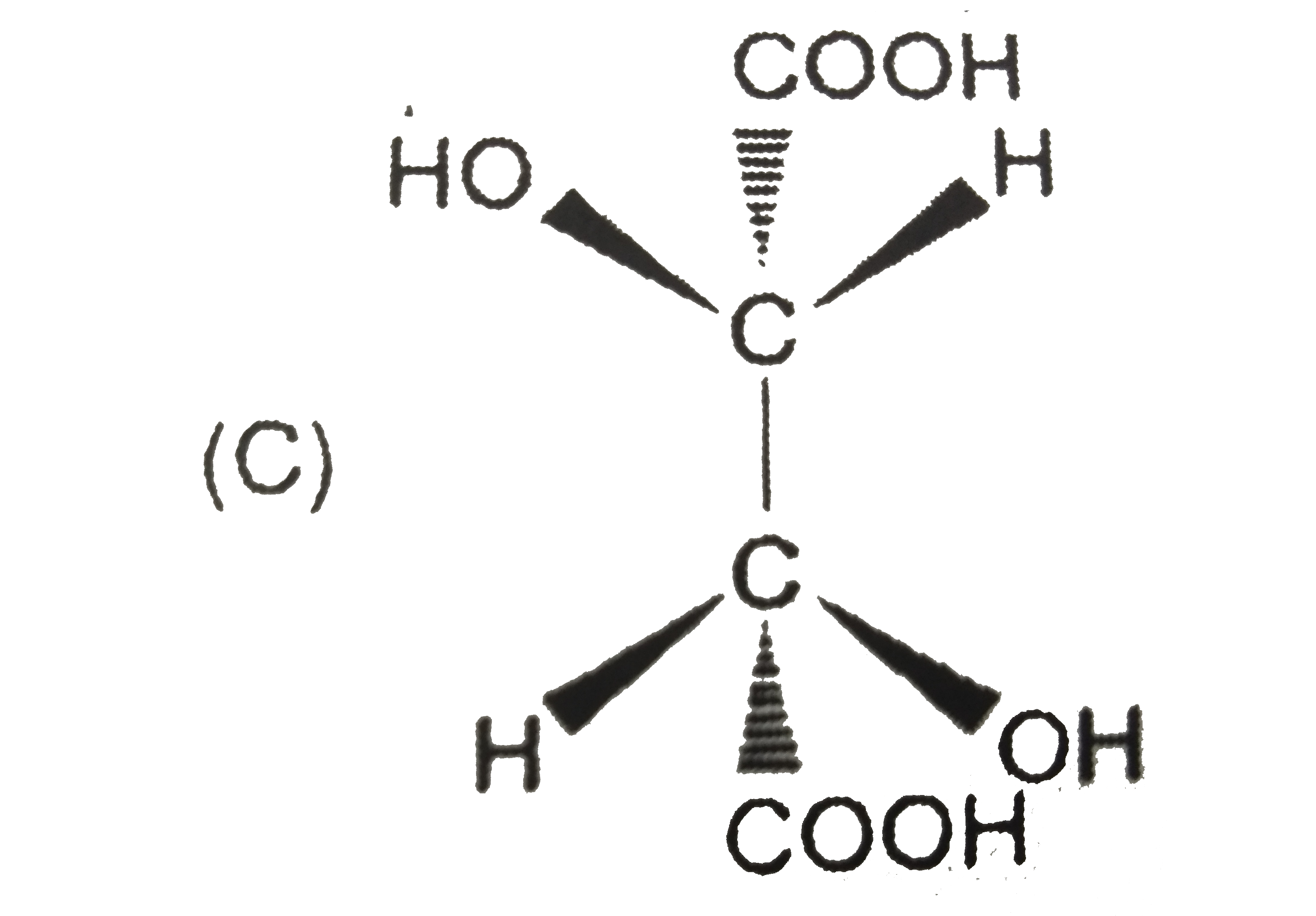A mixture of carboxyliic acids (X) and (Y) cannot be separated by normal methods however when this mixture is treated with optically active quinine give optically acitve salts (P) and (Q). These two salts can be separated by fractional crystallization, separated and acidified with HCl to from amines and carboxylic acids.
The compound (X) and (Y) may be
CH3COOH,CH3CH2COOH

(+) and (−) - Tartaric acid
CH3CH2CH2COOH,CH3CH2CH2CH2COOH
The correct Answer is:C
This is a method of optical resolution because only optically active mixture cannot be separated by usual method hence choice (c) is correct while (a),(b) and (d) are wrong.
Topper's Solved these Questions
- PRACTICAL ORGANIC CHEMISTRYBook:NARAYNAChapter:PRACTICAL ORGANIC CHEMISTRYExercise:SUBJECTIVE_TYPE
Explore 1 Video
- PRACTICAL ORGANIC CHEMISTRYBook:NARAYNAChapter:PRACTICAL ORGANIC CHEMISTRYExercise:SCQ_TYPE
Explore 47 Videos
- POLYMERS Book:NARAYNAChapter:POLYMERS Exercise:EXERCISE -4
Explore 8 Videos
- QUALITATIVE ANALYSISBook:NARAYNAChapter:QUALITATIVE ANALYSISExercise:Subjective Type Question
Explore 33 Videos
Similar Questions
Give reasons for the following :
(a) Carboxylic acids do not give characteristic reactions of carbonyl group.
(b) Treatment of benzaldehyde with HCN gives a mixture of two isomers which cannot be separated even by careful fractional distillation.
(c) Sodium bisulphite is used for the purification of aldehydes and ketones.
View SolutionTartaric acid [HO2CH(OH)CH(OH)CO2H] was an important compound in history of stereochemistry.
Two naturally occuring forms of tartaric acid are optically inactive. One optically inactive form (P) has a melting point of 210-212∘C and can be separated into two optically acitve forms, whereas other optically inactive form (Q) cannot be resolved further.
A optically inactive form P is :
View Solution
Knowledge Check
A mixture of carboxylic acids (X) and (Y) cannot be separated by normal methods howerver when this mixture is treated with optically active quinine give optically acitve salts (P) and (Q). These two salts can be separated by fractional crystallization, separated and acidified with HCl to from amines and carboxylic acids.
(P) and (Q) are separated by fractiional crystallization due toAdifference in boiling pointBdifference in solubilityCdifference in melting poilntDdifference in thermal stabilityThe constituents of a heterogeneous mixture are X, Y and Z. If mixture containing X and Y is taken, X can be separated using magnetic separation, Y and Z can be separated using distillation method. Which of the following best identifies X, Y and Z respectively?
AIron, salt, waterBSulphur, carbon disulphide, waterCGun powder, common salt, waterDlodine, sand, alcoholTartaric acid [HO2CH(OH)CH(OH)CO2H] was an important compound in history of stereochemistry.
Two naturally occuring forms of tartaric acid are optically inactive. One optically inactive form (P) has a melting point of 210-212∘C and can be separated into two optically acitve forms, whereas other optically inactive form (Q) cannot be resolved further.
Optically inactive form Q isA B
B C
C Dnone of these
Dnone of these
A sodium salt X of an unknown anion when treated with MgCI2 gives white precipitate Y only on boiling. It gives lime water test positve but doesn’t gives KMnO4 test. Compound X and Y can't be separately by using:
View SolutionAn analust is trying to separate a mixture containing the following four organic compounds

She dissolved the mixture in ether and treated the solution with aqueous NaOH solution and finally separated the two fractions: Fraction-I (ether) and Fraction-II (aqueous). Later she acidified Fraction-1 and was able to distill the organic compound(s) into ether to obtain third fraction, Fraction-III. Fraction-III was then treated with aqueous NaHCO3 and the two layers, ether layer (Fraction-IV) and aqueous layer (Fraction-V) were separated. Also Fraction-I was treated with aqueous HCl solution and the two layers, other (Fraction-VI) and aquores layer (Fraction-VII) were seperated. Answer the following three questions based on the above information.
Fraction-V on acidification followed by distillation will give
View SolutionAn analust is trying to separate a mixture containing the following four organic compounds

She dissolved the mixture in ether and treated the solution with aqueous NaOH solution and finally separated the two fractions: Fraction-I (ether) and Fraction-II (aqueous). Later she acidified Fraction-1 and was able to distill the organic compound(s) into ether to obtain third fraction, Fraction-III. Fraction-III was then treated with aqueous NaHCO3 and the two layers, ether layer (Fraction-IV) and aqueous layer (Fraction-V) were separated. Also Fraction-I was treated with aqueous HCl solution and the two layers, other (Fraction-VI) and aquores layer (Fraction-VII) were seperated. Answer the following three questions based on the above information.
The species left in fraction VI is
View SolutionAn analust is trying to separate a mixture containing the following four organic compounds

She dissolved the mixture in ether and treated the solution with aqueous NaOH solution and finally separated the two fractions: Fraction-I (ether) and Fraction-II (aqueous). Later she acidified Fraction-1 and was able to distill the organic compound(s) into ether to obtain third fraction, Fraction-III. Fraction-III was then treated with aqueous NaHCO3 and the two layers, ether layer (Fraction-IV) and aqueous layer (Fraction-V) were separated. Also Fraction-I was treated with aqueous HCl solution and the two layers, other (Fraction-VI) and aquores layer (Fraction-VII) were seperated. Answer the following three questions based on the above information.
What is true about the species left in fraction-IV?
View SolutionTwo elements X and Y react separately with highly electropositve metal to form binary compounds, which upon hydrolysis yield mixture of boranes and silances. X and Y respectively are
View Solution

